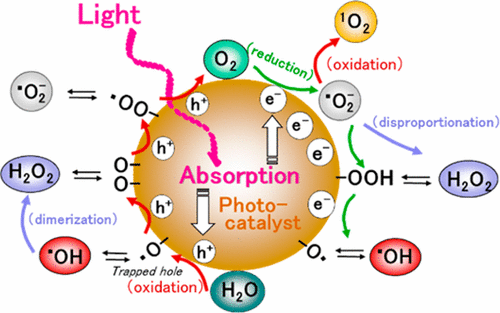当前位置:
X-MOL 学术
›
Chem. Rev.
›
论文详情
Our official English website, www.x-mol.net, welcomes your
feedback! (Note: you will need to create a separate account there.)
Generation and Detection of Reactive Oxygen Species in Photocatalysis
Chemical Reviews ( IF 51.4 ) Pub Date : 2017-08-04 00:00:00 , DOI: 10.1021/acs.chemrev.7b00161 Yoshio Nosaka 1 , Atsuko Y. Nosaka 1
Chemical Reviews ( IF 51.4 ) Pub Date : 2017-08-04 00:00:00 , DOI: 10.1021/acs.chemrev.7b00161 Yoshio Nosaka 1 , Atsuko Y. Nosaka 1
Affiliation

|
The detection methods and generation mechanisms of the intrinsic reactive oxygen species (ROS), i.e., superoxide anion radical (•O2–), hydrogen peroxide (H2O2), singlet oxygen (1O2), and hydroxyl radical (•OH) in photocatalysis, were surveyed comprehensively. Consequently, the major photocatalyst used in heterogeneous photocatalytic systems was found to be TiO2. However, besides TiO2 some representative photocatalysts were also involved in the discussion. Among the various issues we focused on the detection methods and generation reactions of ROS in the aqueous suspensions of photocatalysts. On the careful account of the experimental results presented so far, we proposed the following apprehension: adsorbed •OH could be regarded as trapped holes, which are involved in a rapid adsorption–desorption equilibrium at the TiO2–solution interface. Because the equilibrium shifts to the adsorption side, trapped holes must be actually the dominant oxidation species whereas •OH in solution would exert the reactivity mainly for nonadsorbed reactants. The most probable routes of generating intrinsic ROS at the surfaces of two polymorphs of TiO2, anatase and rutile, were discussed along with some plausible rational reaction processes. In addition to the four major ROS, three ROS, that is organic peroxides, ozone, and nitric oxide, which are less common in photocatalysis are also briefly reviewed.
中文翻译:

光催化中活性氧的产生和检测
内在活性氧(ROS)的检测方法和生成机理,即超氧阴离子自由基(• O 2 –),过氧化氢(H 2 O 2),单线态氧(1 O 2)和羟基自由基(• OH)在光催化方面,进行了全面的调查。因此,发现在非均相光催化体系中使用的主要光催化剂为TiO 2。但是,除了TiO 2一些代表性的光催化剂也参与了讨论。在各种问题中,我们集中于光催化剂水悬浮液中ROS的检测方法和生成反应。仔细考虑到目前为止的实验结果,我们提出以下理解:吸附• OH可以看作是陷阱,它们参与了TiO 2-溶液界面的快速吸附-解吸平衡。因为平衡转移到吸附侧,所以陷井实际上必须是主要的氧化物质,而•溶液中的OH将主要对未吸附的反应物发挥反应性。在TiO的两种多晶型物表面上生成内在ROS的最可能途径讨论了锐钛矿和金红石2,以及一些合理的合理反应过程。除了四种主要的ROS外,还简要回顾了三种ROS,即在光催化中不常见的有机过氧化物,臭氧和一氧化氮。
更新日期:2017-08-04
中文翻译:

光催化中活性氧的产生和检测
内在活性氧(ROS)的检测方法和生成机理,即超氧阴离子自由基(• O 2 –),过氧化氢(H 2 O 2),单线态氧(1 O 2)和羟基自由基(• OH)在光催化方面,进行了全面的调查。因此,发现在非均相光催化体系中使用的主要光催化剂为TiO 2。但是,除了TiO 2一些代表性的光催化剂也参与了讨论。在各种问题中,我们集中于光催化剂水悬浮液中ROS的检测方法和生成反应。仔细考虑到目前为止的实验结果,我们提出以下理解:吸附• OH可以看作是陷阱,它们参与了TiO 2-溶液界面的快速吸附-解吸平衡。因为平衡转移到吸附侧,所以陷井实际上必须是主要的氧化物质,而•溶液中的OH将主要对未吸附的反应物发挥反应性。在TiO的两种多晶型物表面上生成内在ROS的最可能途径讨论了锐钛矿和金红石2,以及一些合理的合理反应过程。除了四种主要的ROS外,还简要回顾了三种ROS,即在光催化中不常见的有机过氧化物,臭氧和一氧化氮。











































 京公网安备 11010802027423号
京公网安备 11010802027423号